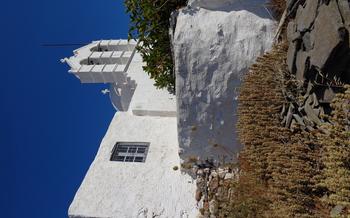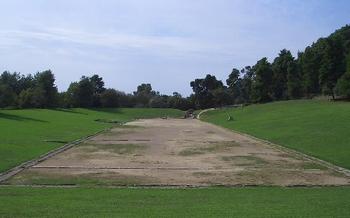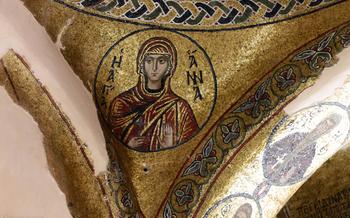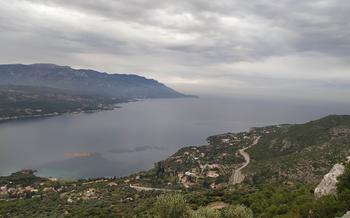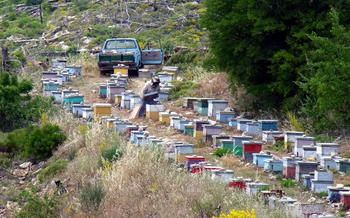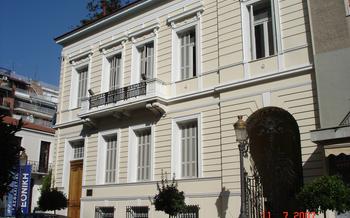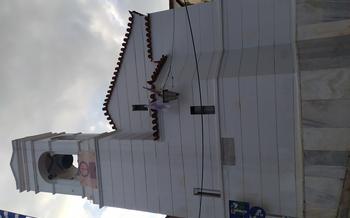
Saint Paraskevi Church in Gritsa
- The History of Saint Paraskevi Church
- The Architecture of Saint Paraskevi Church
- The Interior of Saint Paraskevi Church
- The Saint Paraskevi Icon
- Religious Festivals and Celebrations
- The Role of the Church in the Community
- The Pilgrimages to Saint Paraskevi Church
- Reasons Why People Undertake Pilgrimages
- Rituals and Traditions Associated with Pilgrimages
- Anecdotes and Stories from Pilgrims
- The Local Legends and Beliefs
- Archaeological Wonders Unveiled: Exploring the Past at Saint Paraskevi Church
- The Surrounding Area
- Local Cuisine and Dining Options
- Accommodation Options
- Transportation and Getting There
- Visitor Tips and Etiquette
- Insider Tip: Embark on a Culinary Journey
The History of Saint Paraskevi Church
In the heart of Gritsa, a picturesque neighborhood in Katerini, Greece, stands the beautiful Saint Paraskevi Church, a testament to faith, devotion, and architectural splendor. Built in the 19th century, the church has witnessed centuries of history, serving as a spiritual beacon for the local community and attracting visitors from far and wide.
The church was constructed on the site of an older chapel dedicated to the same saint, Saint Paraskevi, who is widely venerated throughout Greece and the Orthodox world. The original chapel was believed to have existed as early as the 16th century and was a place of pilgrimage for those seeking divine intervention and healing.
As the community grew and the need for a larger church became apparent, the decision was made to erect a new building that would accommodate the increasing number of faithful. The construction of the new Saint Paraskevi Church began in the mid-19th century and was completed in 1864, with the church being consecrated and opened for worship in the same year.
The Saint Paraskevi Church holds great historical and cultural significance, not only for Gritsa but also for the wider region of Pieria. It represents the deep-rooted Orthodox Christian faith of the local people and serves as a reminder of the rich religious heritage of Greece. The church's architectural style, with its distinctive features and unique elements, showcases the skill and artistry of the builders and reflects the architectural traditions of the period.
The Architecture of Saint Paraskevi Church
The architectural style of Saint Paraskevi Church is a unique blend of Byzantine and Ottoman influences, reflecting the region's rich history. The church features a domed roof, which is a characteristic element of Byzantine architecture, and a minaret, which is a feature commonly found in Ottoman mosques. The exterior of the church is adorned with intricate stone carvings and decorative elements, showcasing the skilled craftsmanship of the builders. The interior of the church is equally impressive, with a spacious layout and a stunning array of frescoes and iconography that adorn the walls and ceilings. These frescoes depict scenes from the Bible and the lives of various saints, showcasing the artistic talents of the local craftsmen. The church also boasts a beautiful iconostasis, which is a traditional screen that separates the sanctuary from the nave. The iconostasis is adorned with intricate carvings and features a collection of icons that depict Jesus Christ, the Virgin Mary, and various saints.
The Interior of Saint Paraskevi Church
The interior of Saint Paraskevi Church is a breathtaking display of Byzantine art and architecture. The layout is typical of Greek Orthodox churches, with a central nave flanked by two aisles. The walls are adorned with exquisite frescoes depicting scenes from the Bible and the life of Saint Paraskevi. The iconostasis, a wall of icons that separates the nave from the sanctuary, is a masterpiece of wood carving and iconography. It features a series of icons depicting Christ, the Virgin Mary, and various saints.
The church also houses a number of religious artifacts and relics, including a silver reliquary containing the skull of Saint Paraskevi. The atmosphere inside the church is one of reverence and spirituality. The soft light filtering through the stained glass windows, the smell of incense, and the sound of chanting create a sense of peace and tranquility.
One of the most striking features of the interior is the icon of Saint Paraskevi, which is placed in a prominent position on the iconostasis. The icon is said to have been painted by Saint Luke the Evangelist, and it is believed to possess miraculous powers. Many pilgrims come to the church to venerate the icon and to pray for Saint Paraskevi's intercession.
The Saint Paraskevi Icon
The Saint Paraskevi icon is the most revered and beloved religious artifact in the church. It is believed to date back to the 13th century, and it is said to have been painted by a monk who had a vision of the saint. The icon depicts Saint Paraskevi standing in a majestic pose, her head crowned with a halo and her eyes gazing out at the viewer. She is dressed in a beautiful red robe, and she holds a cross in her right hand and a book in her left. The icon is adorned with intricate gold and silverwork, and it is surrounded by a frame of precious stones.
The Saint Paraskevi icon is considered to be miraculous, and many people have attributed their good fortune and healing to its intercession. Over the centuries, the icon has been carried in processions and displayed during religious festivals. It has also been used to bless the sick and to protect the community from harm. The icon is deeply revered by the local people, and it is a symbol of their faith and devotion.
In addition to its religious significance, the Saint Paraskevi icon is also a work of art. It is a beautiful example of Byzantine iconography, and it is a testament to the skill and artistry of the monk who painted it. The icon is a reminder of the rich cultural heritage of Greece, and it is a treasure that is cherished by the people of Katerini.
Religious Festivals and Celebrations
Saint Paraskevi Church is the heart of religious life in Gritsa, and every year, it hosts a series of vibrant festivals and celebrations that bring the community together. The most prominent of these is the annual feast day of Saint Paraskevi, held on July 26th. During this festival, the church is adorned with colorful decorations, and a grand procession takes place through the village streets. The procession carries the Saint Paraskevi icon, followed by devout believers singing hymns and prayers. The festival culminates in a festive gathering at the church courtyard, where locals and visitors alike come together to share food, music, and dance. Other notable celebrations include Easter, Christmas, and the Dormition of the Virgin Mary, each marked by unique traditions and rituals. These festivals are not merely religious observances but also serve as social events, reinforcing the bonds within the community and showcasing the rich cultural heritage of Gritsa.
The Role of the Church in the Community
The Saint Paraskevi Church plays a crucial role in the religious and cultural life of the local community. It serves as a spiritual center for the faithful, providing a place for worship, prayer, and contemplation. The church also organizes various religious festivals and celebrations throughout the year, fostering a sense of unity and belonging among the community members. Beyond its religious significance, the church is actively involved in social and charitable activities, reaching out to those in need. It operates soup kitchens, food banks, and shelters, offering assistance to the vulnerable and marginalized. The church also supports local initiatives aimed at preserving cultural heritage and promoting community development. Through these endeavors, the Saint Paraskevi Church plays a vital role in strengthening the bonds within the community and contributing to its overall well-being.
The Pilgrimages to Saint Paraskevi Church
The history of pilgrimages to Saint Paraskevi Church dates back centuries, with people from all over Greece and beyond flocking to the church to seek blessings, healing, and spiritual guidance. The church is believed to possess miraculous powers, and many pilgrims have reported experiencing divine interventions and healings after visiting the church.
Reasons Why People Undertake Pilgrimages
There are many reasons why people undertake pilgrimages to Saint Paraskevi Church. Some pilgrims come to seek healing for illnesses or injuries, while others come to pray for a loved one in need. Still, others come to seek spiritual enlightenment or to give thanks for blessings received.
Rituals and Traditions Associated with Pilgrimages
Pilgrims to Saint Paraskevi Church often engage in various rituals and traditions. These include lighting candles, offering prayers, and touching the icon of Saint Paraskevi. Some pilgrims also choose to walk barefoot to the church as a sign of devotion.
Anecdotes and Stories from Pilgrims
There are many anecdotes and stories from pilgrims who have visited Saint Paraskevi Church. Some pilgrims have reported experiencing miraculous healings, while others have shared stories of spiritual transformation and enlightenment. These stories serve as a testament to the powerful faith and devotion that pilgrims have for Saint Paraskevi.
The Local Legends and Beliefs
The Saint Paraskevi Church in Gritsa is steeped in local legends and beliefs that have been passed down through generations, adding to its mystique and allure. One popular legend tells of a young woman named Paraskevi who dedicated her life to Christianity and was martyred for her faith. According to the legend, her body was miraculously preserved and transported to Gritsa, where the church was built in her honor.
Another legend speaks of a miraculous spring that appeared on the site of the church. It is believed that the water from this spring possesses healing powers and has been used for centuries to cure various ailments. Pilgrims from all over the region come to the church to drink from the spring and seek divine intervention for their illnesses.
The church is also associated with a number of local customs and traditions. For example, on the feast day of Saint Paraskevi, it is customary for the faithful to bring flowers and offerings to the church. They also participate in a special religious procession that winds its way through the streets of Gritsa, accompanied by traditional music and dancing.
These legends, beliefs, and traditions have played a significant role in shaping the local culture and identity. They have also contributed to the church's reputation as a sacred and miraculous place, attracting pilgrims and visitors from far and wide.
Archaeological Wonders Unveiled: Exploring the Past at Saint Paraskevi Church
The vicinity of Saint Paraskevi Church holds a treasure trove of archaeological discoveries that shed light on the region's rich history. Over the years, excavations have unearthed ancient artifacts, ruins, and structures that provide valuable insights into the lives and civilizations that once thrived here.
One of the most notable discoveries is an ancient settlement dating back to the Bronze Age. Archaeologists have uncovered remnants of houses, pottery, and tools, suggesting that this area was once home to a thriving community. The findings offer a glimpse into the daily lives and cultural practices of the region's earliest inhabitants.
Another significant discovery is a necropolis, or ancient cemetery, located near the church. Excavations have revealed numerous tombs and burials, providing valuable information about the funerary customs and beliefs of the local population. The artifacts found within the tombs, such as jewelry, pottery, and weapons, offer clues about the social status and wealth of the deceased.
The archaeological discoveries at Saint Paraskevi Church have contributed significantly to our understanding of the region's past. They provide a tangible connection to the lives and cultures of ancient civilizations, shedding light on their customs, traditions, and beliefs. Ongoing archaeological research in the area holds the potential for further exciting discoveries, promising to reveal even more secrets of this fascinating region's history.
The Surrounding Area
The region surrounding Saint Paraskevi Church is a treasure trove of natural beauty and cultural heritage. Embark on a scenic hike through the picturesque landscapes, immersing yourself in the tranquility of nature. Discover hidden waterfalls, lush forests, and breathtaking views that will leave you awe-inspired.
Visit the nearby historical and cultural landmarks, such as ancient ruins, monasteries, and traditional villages, each with its own unique story to tell. Delve into the region's rich history and cultural traditions, gaining a deeper appreciation for the local way of life.
For adventure enthusiasts, there are ample opportunities for outdoor activities and recreation. Engage in thrilling water sports, embark on challenging mountain biking trails, or simply relax on the pristine beaches, soaking up the Mediterranean sun.
To create a memorable itinerary, consider exploring the surrounding area by renting a bicycle or joining an organized tour. This will allow you to fully immerse yourself in the region's beauty and discover hidden gems that might otherwise be missed.
Local Cuisine and Dining Options
Indulge in the culinary delights of the region when visiting Saint Paraskevi Church in Gritsa. The area boasts a rich gastronomic heritage, offering a tantalizing array of traditional dishes and culinary specialties. From savory pies bursting with local cheeses and fresh herbs to succulent grilled meats and seafood delicacies, there's something to satisfy every palate.
Nestled near the church, you'll find a charming selection of restaurants and tavernas, each offering a unique culinary experience. Immerse yourself in the warm hospitality and vibrant atmosphere as you savor authentic Greek cuisine prepared with love and fresh, local ingredients.
For a truly unforgettable dining experience, be sure to try the region's signature dishes, such as the slow-cooked kleftiko lamb, the aromatic moussaka, or the mouthwatering spanakopita. Vegetarians will delight in the variety of fresh salads, grilled vegetables, and hearty vegetarian stews.
When it comes to seafood, the options are endless. From grilled octopus and calamari to succulent shrimp and sea bass, the local tavernas offer a delectable array of dishes that showcase the bounty of the Aegean Sea.
No meal is complete without a taste of the region's renowned wines. From crisp whites to robust reds, there's a perfect pairing for every dish. Ask your server for recommendations or venture out and discover your own favorites.
Whether you're seeking a casual lunch spot or a romantic dinner setting, the area surrounding Saint Paraskevi Church offers a delightful culinary adventure waiting to be explored. Embrace the opportunity to savor the flavors of Greece and create lasting memories over a delicious meal.
Accommodation Options
Saint Paraskevi Church is situated in the heart of a vibrant neighborhood, offering a wide range of accommodation options for visitors. Whether you seek budget-friendly guesthouses, comfortable mid-range hotels, or luxurious resorts, you'll find something to suit your preferences and budget.
For those seeking a budget-friendly option, there are several guesthouses and hostels within walking distance of the church. These establishments offer basic but clean and comfortable accommodations, perfect for travelers on a tight budget.
For those looking for a more comfortable stay, there are several mid-range hotels in the vicinity. These hotels offer a range of amenities, including private bathrooms, air conditioning, and breakfast included in the room rate.
For those seeking a luxurious experience, there are several high-end hotels and resorts in the area. These establishments offer spacious rooms, top-notch amenities, and stunning views of the surrounding landscape.
To ensure a hassle-free stay, it is advisable to book your accommodation in advance, especially during the peak tourist season. Online booking platforms and travel agents can help you find the best deals and compare prices from different providers.
Transportation and Getting There
Reaching Saint Paraskevi Church is a breeze, thanks to the excellent transportation network in the region. If you're traveling from a major city like Athens or Thessaloniki, several direct buses and trains connect to Katerini, the nearest city to the church. From there, you can hop on a local bus or taxi that will take you directly to Gritsa village.
For a more flexible and independent journey, consider renting a car. The roads are well-maintained, and the drive offers stunning views of the countryside. Just be sure to book your rental in advance during peak tourist season.
If you prefer a hassle-free option, hiring a taxi is a great choice. Taxis are readily available at major transportation hubs and can be arranged through your hotel or local tour operator. They offer a convenient and comfortable way to travel directly to the church.
Once you arrive in Gritsa village, follow the signs to the church, which is just a short walk from the main square. Its prominent location makes it easy to find, and you'll be greeted by the church's serene atmosphere as you approach.
Visitor Tips and Etiquette
When visiting Saint Paraskevi Church, it is essential to be mindful of local customs and religious traditions. Dress modestly and respectfully, covering your shoulders and knees. Photography is generally allowed inside the church, but it is essential to be discreet and avoid using flash photography. When taking photos, be sure not to disturb other visitors or block their view. If you have any questions or need assistance, do not hesitate to ask a member of the church staff or a local resident. They will be more than happy to help you.
Remember to be respectful of the church's sanctity and maintain a quiet and contemplative demeanor. This sacred space is a place of worship and reflection, and it is essential to honor its spiritual significance. By following these simple guidelines, you can ensure a meaningful and enriching experience at Saint Paraskevi Church.
Insider Tip: Embark on a Culinary Journey
Discover the hidden culinary gem of "To Steki tou Ilia," a traditional Greek tavern nestled just a stone's throw from Saint Paraskevi Church. Indulge in authentic homemade dishes prepared with fresh, local ingredients, capturing the essence of Greek cuisine. Savor the flavors of slow-cooked stews, succulent grilled meats, and mouthwatering seafood, all while enjoying the warm hospitality of the family-run establishment. Don't miss the chance to immerse yourself in the true culinary spirit of the region and make your visit to Saint Paraskevi Church an unforgettable gastronomic experience.
